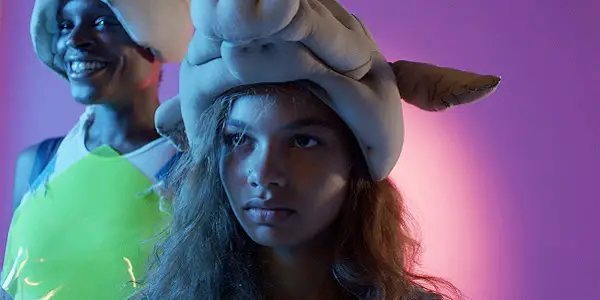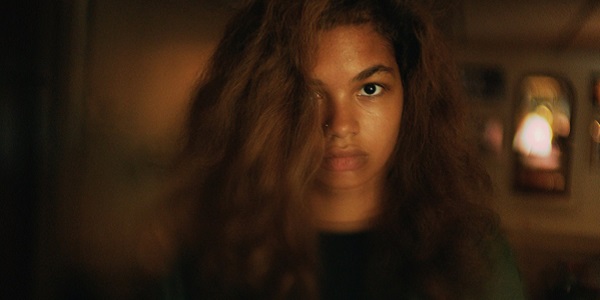MADELINE’S MADELINE: A Wild Ride Into One Girl’s Tortured Mind

Lee Jutton has directed short films starring a killer toaster,…
In filmmaker Josephine Decker’s Sundance smash Madeline’s Madeline, an aspiring young actress finds her complicated internal life slowly becoming the subject of the experimental theater production of which she is an integral part. If it sounds unusual, well, that would be putting it mildly. Madeline’s Madeline turns traditional narrative structure on its head and shakes it vigorously. The film is often too hard to wrap one’s brain around, but thanks to the talented women involved in the production, both onscreen and off, it never stops being fascinating to watch.
Theater of the Surreal
Madeline (newcomer Helena Howard) is a 16-year-old member of an experimental acting troupe led by the visionary theater director Evangeline (Molly Parker), who has her actors spend less time reciting dialogue and more time trying unusual movement exercises and attempting to “become” wild animals. Madeline is incredibly talented, but it’s also clear that she carries with her a great deal of emotional baggage that fuels her intense performances. A history of mental illness, including a brief spell in a psych ward, is hinted at but never fully explained.
Madeline’s every move is smothered by her overly sensitive mother, Regina (Miranda July), who channels her obsessive worry over Madeline’s apparently fragile mental state into behavior that qualifies as abuse. In hazy, surreal sequences full of overlapping dialogue and images, we see Madeline and Regina wrestle with each other verbally and physically; later, they lie on a blanket in a park, joking about passersby as though nothing had happened at all. Their relationship is a rollercoaster that often seems on the verge of flying off the tracks and crashing into the void.

It is not clear if Regina’s toxic treatment of Madeline precipitated a psychotic break, or if it came after; what is clear is that Madeline feels incapable of living up to her mother’s high expectations for the child she describes as having been a perfect baby. Instead, Madeline treats Evangeline as a substitute mother figure, and Evangeline, who is pregnant, is all too willing to oblige. After Madeline tells Evangeline about a dream she had where she smashed Regina’s hand with an iron, Evangeline tells Madeline, “I had a dream you were my daughter.”
Madeline is mixed-race; Regina is white. Evangeline is white too, but when she takes Madeline home to meet her family, Madeline learns that Evangeline’s husband is black; their child will be mixed-race like she is. It becomes clear that this is why Evangeline is obsessed with Madeline and her complicated relationship with her mother, even going so far as to restructure her theater project around Madeline’s dream and to invite Regina to partake in their rehearsals; she is attempting to get inside the head of a mixed-race child with a white mom to try and understand what might await her. Surrounded by selfishness masquerading as maternal love on all sides, with the lines between real life and the theater increasingly blurred, it’s only a matter of time before something inside Madeline snaps.
Teenage (Fever) Dream
Decker is known for her surreal storytelling techniques, so it should be no surprise that Madeline’s Madeline is as narratively opaque as your average David Lynch film. If you appreciate filmmaking reminiscent of a fever dream, then you will appreciate a great deal about Madeline’s Madeline; if you do not, then this film is most definitely not for you. As the film progresses, it becomes more and more difficult to differentiate Madeline’s reality from her fantasy world, especially as Evangeline’s immersive theatrical production takes on more and more of a resemblance to Madeline’s inner life. It’s often difficult to discern whether a scene is real or imaginary — or just part of the theatrical production, and thus straddling the two.
The visual style of Madeline’s Madeline is a match for its storytelling structure in its dizzying effect on the audience. Director of photography Ashley Connor utilizes a shaky, hallucinatory style that befits Madeline’s mental state but isn’t always easy on the eyes, especially when the film leans heavily into kaleidoscopic double-exposure. Frequent use of overlapping dialogue that rises and falls in volume and intensity completes the messy picture of the inside of Madeline’s head.

Even if Decker’s style drives you crazy with its purposeful incomprehensibility, one cannot help but appreciate the powerful performances of the three women at the center of the story. Molly Parker, always an underrated actress, infuses Evangeline with her own signature toughness, making it clear that the theater director will not hesitate to make any sacrifice for her art – even if the sacrifice is not hers to make. The acclaimed author, artist and filmmaker Miranda July is a bundle of contradictions as Regina, her delicate elfin features belying the anger within and making her outbursts at Madeline all the more disturbing.
And Madeline herself? As portrayed by the luminous newcomer Helena Howard, she is an enigma, but a fascinating one. Howard’s performance carries an aura of intelligence and intensity far beyond her years (as of right now, she is only 19). She plunges into the depths of Madeline’s tortured psyche and pulls you down there with her, whether you like it or not. It is a remarkable performance from a unique young actor who should see many more exciting opportunities come her way as a result.
Madeline’s Madeline: Conclusion
Thanks to the complicated and charismatic women at its center, Madeline’s Madeline manages to keep you hooked even as you grow increasingly unable to understand what the hell is actually going on. Like wildly weird brand of immersive theater that Evangeline teaches, the film is definitely divisive; the more amenable you are to experimental storytelling that elicits more questions than answers, the more likely you are to appreciate this film.
I walked away not entirely sure what I had just watched, or why – only that it was unlike anything I had seen in recent memory.
What do you think? Does the premise of Madeline’s Madeline sound intriguing or just too incomprehensible? Share your thoughts in the comments below.
Madeline’s Madeline will be released in theaters in the U.S. on August 10, 2018. For more international release dates, see here.
Does content like this matter to you?
Become a Member and support film journalism. Unlock access to all of Film Inquiry`s great articles. Join a community of like-minded readers who are passionate about cinema - get access to our private members Network, give back to independent filmmakers, and more.
Lee Jutton has directed short films starring a killer toaster, a killer Christmas tree, and a not-killer leopard. Her writing has appeared in publications such as Film School Rejects, Bitch: A Feminist Response to Pop Culture, Bitch Flicks, TV Fanatic, and Just Press Play. When not watching, making, or writing about films, she can usually be found on Twitter obsessing over soccer, BTS, and her cat.













